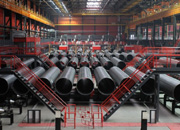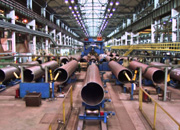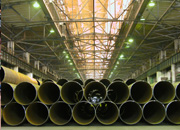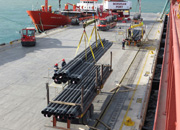Compared with the same period last year, the output of
seamless steel pipes has increased by 8.56% in the first quarter and 10.58% in the second quarter, showing an upward trend. Therefore, in the second half of the year, attention should be paid to preventing the total production of seamless steel pipes from growing too fast.
First, the method of drilling seamless steel pipes
1. Use a special perforator to drill the inner diameter of the seamless steel pipe to the required specifications. Before drilling, check whether the pipe has cracks, folds, severe rust, and other defects. If there are any of the above defects, they must be removed before drilling.
2. Select the corresponding drill bit on the perforator according to the required specifications of the seamless steel pipe (generally a diamond-beaded electric drill bit with a diameter of 32mm or 40mm is used), and then adjust the appropriate speed and feed amount to start drilling.
3. When the wall thickness of the seamless steel pipe is less than 4mm, a small-diameter diamond beaded electric drill bit can be selected; if the wall thickness is greater than 4mm, a large-diameter diamond beaded electric drill bit (such as Φ50) should be used.
4. During the drilling process, pay attention to the bottom of the hole at any time and adjust the speed and feed amount in time to prevent wire breakage.
5. When the seamless steel pipe passes through the metal casing, the hole-piercing operation is completed.
Second, precautions for seamless steel pipe drilling
1. It is strictly forbidden to use the electric hammer impact method to process and perforate seamless steel pipes with severe cracks; otherwise, the strength of the seamless steel pipe will be destroyed and the service life will be affected. If defects such as cracks, heavy skin, or scars are found on the surface of the steel, and deep scratches are found locally, the electric hammer processing method should also be avoided. (This method is not suitable for seamless steel pipes made of hot-rolled steel plates by cold drawing)
2. For seamless stainless steel pipes used for gas transportation, a water pressure test is usually used to check whether their pressure resistance meets the requirements (according to standard GB/T12771-2000: the water pressure test pressure is 1.5 times the working pressure, and the pressure holding time is not less than 5 seconds).
3. For seamless stainless steel pipes used for hydraulic props, the hydraulic test is usually used to check whether their pressure resistance meets the requirements (according to standard GB/T12771-2000: the hydraulic test pressure is 1.15 times the nominal pressure; the pressure stabilization time is not less than 10 seconds).
4. For seamless stainless steel pipes for boilers that bear fluid loads and have high working temperatures, leakage detection is required when they are often used as liquid transportation pipelines. (According to standard GB/T13396-92: the leakage detection pressure is 2 times the nominal pressure; the time is 30 minutes.)
5. For high-pressure oil pipes used for high-pressure containers, leakage detection is required when they are often used as gas transportation pipelines. (According to the standard GB/T14383-93: the leakage detection pressure is 2.5 times the nominal pressure; the time is 1 hour.)
6. Since cracks are easily generated at the welding joints, the effective cross-sectional area of the weld is reduced, causing leakage to increase and even catastrophic accidents to occur. Therefore, the welding quality must be strictly controlled.
 Threeway Steel is known as a professional supplier engaged in manufacturing and distributing a wide range of steel pipe, and our headquarter located the central part of China – Hunan and six associated factories throughout China.
Threeway Steel is known as a professional supplier engaged in manufacturing and distributing a wide range of steel pipe, and our headquarter located the central part of China – Hunan and six associated factories throughout China.
 Threeway Steel is known as a professional supplier engaged in designing, manufacturing and distribution of a wide range of steel products with the headquarter located the central part of China – Hunan and six associated factories throughout China.
Threeway Steel is known as a professional supplier engaged in designing, manufacturing and distribution of a wide range of steel products with the headquarter located the central part of China – Hunan and six associated factories throughout China.
 Threeway Steel is known as a professional supplier engaged in designing, manufacturing and distribution of a wide range of steel products with the headquarter located the central part of China – Hunan and six associated factories throughout China.
Threeway Steel is known as a professional supplier engaged in designing, manufacturing and distribution of a wide range of steel products with the headquarter located the central part of China – Hunan and six associated factories throughout China.
 Threeway Steel is known as a professional supplier engaged in designing, manufacturing and distribution of a wide range of steel products with the headquarter located the central part of China – Hunan and six associated factories throughout China.
Threeway Steel is known as a professional supplier engaged in designing, manufacturing and distribution of a wide range of steel products with the headquarter located the central part of China – Hunan and six associated factories throughout China.
 Threeway Steel is known as a professional supplier engaged in designing, manufacturing and distribution of a wide range of steel products with the headquarter located the central part of China – Hunan and six associated factories throughout China.
Threeway Steel is known as a professional supplier engaged in designing, manufacturing and distribution of a wide range of steel products with the headquarter located the central part of China – Hunan and six associated factories throughout China.

